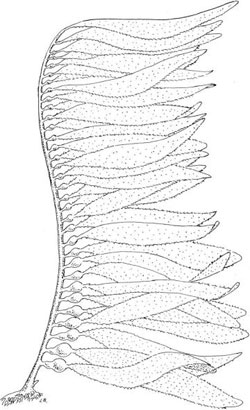Alginate
Alginates are cell-wall constituents of brown algae (Phaeophyceae). They are chain-forming heteropolysaccharides made up of blocks of mannuronic acid and guluronic acid. Composition of the blocks depends on the species being used for extraction and the part of the thallus from which extraction is made. Extraction procedures probably also affect alginate quality. Alginates of one kind or another seem to be present in most species of brown algae but they occur in exploitable quantities (30–45% d. w.) only in the larger kelps and wracks (Laminariales and Fucales). The more useful brown macroalgae grow in cold waters, thriving best in waters up to about
20°C. Brown macroalgae are also found in warmer waters, but these are less suitable for alginate production and are rarely used as food. A wide variety of species are used, harvested in both the northern and southern hemispheres.
The ammonia and alkali metal salts of alginic acid readily dissolve in cold water at low concentrations to give viscous solutions. Alginates, especially sodium alginate, are widely used in the textile industry because they form an excellent dressing and polishing material.
Calcium alginate, which is insoluble in water, has been used in the manufacture of a medical dressing very suitable
for burns and extensive wounds where a normal dressing would be extremely difficult to remove; the calcium alginate is extruded to make a fiber which is then woven into a gauze-like product; alginates with a high proportion of guluronic acid blocks are most suitable for this purpose. When applied to either a wound or burn, a network is formed around which a healthy scab may form; the bandage may be removed with a sodium chloride solution, which renders the alginate soluble in water.
Alginates are also used as a thickening paste for colors in printing textiles, as a hardener and thickener for joining threads in weaving; the alginates may subsequently be dissolved away, giving special effects to the material. Other uses include glazing and sizing paper, special printers’ inks, paints, cosmetics, insecticides, and pharmaceutical preparations. In the U.S. alginates are frequently used as stabilizers in ice cream, giving a smooth texture and body, and also as a suspending agent in milk shakes. Alginates take up atomically heavy metals in a series of affinities; for example, lead and other heavy metals will be taken up in preference
to sodium, potassium, and other “lighter” metals; accordingly, alginates are useful in lead and strontium-90 poisoning.

FIGURE 7.13 Frond of Macrocystis pyrifera.
Approximately 32,000–39,000 tons of alginic acid per annum are extracted worldwide. The main producers are Scotland, Norway, China, and the U.S., with smaller amounts being produced in Japan, Chile, Argentina, South Africa, Australia, Canada, Chile, the U.K., Mexico, and France. In the U.S., the giant kelp, Macrocystis pyrifera is used (Figure 7.13); it is harvested from large offshore beds off the coasts of California and Mexico. Around 50,000 tons wet weight are gathered each year using ships equipped with cutting machinery. Macrocystis has the distinction of being the largest macroalgae in the world; the largest attached plant recorded was 65 m long and the plants are capable of growing at up to 50 cm day
-1. Ascophyllum nodosum and Laminaria hyperborea are used in Norway and Scotland. Ascophyllum is sustainably harvested in Ireland to produce macroalgae meal that is exported to Scotland for alginate extraction.
A decrease in the demand for alginatesin recent years has reduced this harvest to about 15,000 tons in 2001, yielding about 3000 tons of meal for alginates. About 6000–8000 tons of alginates are produced from this and other sources (kelp from Chile and Australia) in Scotland, but the amounts of weed used are not known. Norway processes L. hyperborea, manufacturing about 5000 tons of high-quality alginates. Japan produces about 1500–2500 tons of alginates from kelps. China, a relatively recent addition to the alginate manufacturers of the world, produces about 8000–10000 tons of alginates from cultivated
L. japonica. Alginate production is valued at U.S. $213 million annually.

FIGURE 7.13 Frond of Macrocystis pyrifera.





